Input interpretation

O_2 oxygen + CH_4 methane ⟶ CH_3OH methanol
Balanced equation
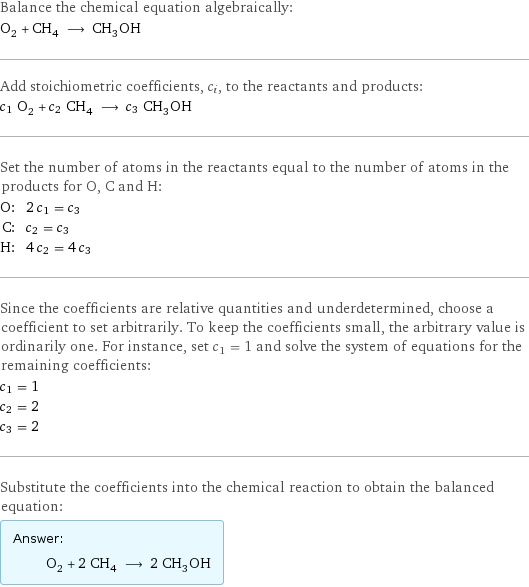
Balance the chemical equation algebraically: O_2 + CH_4 ⟶ CH_3OH Add stoichiometric coefficients, c_i, to the reactants and products: c_1 O_2 + c_2 CH_4 ⟶ c_3 CH_3OH Set the number of atoms in the reactants equal to the number of atoms in the products for O, C and H: O: | 2 c_1 = c_3 C: | c_2 = c_3 H: | 4 c_2 = 4 c_3 Since the coefficients are relative quantities and underdetermined, choose a coefficient to set arbitrarily. To keep the coefficients small, the arbitrary value is ordinarily one. For instance, set c_1 = 1 and solve the system of equations for the remaining coefficients: c_1 = 1 c_2 = 2 c_3 = 2 Substitute the coefficients into the chemical reaction to obtain the balanced equation: Answer: | | O_2 + 2 CH_4 ⟶ 2 CH_3OH
Structures

+ ⟶
Names

oxygen + methane ⟶ methanol
Reaction thermodynamics
Enthalpy
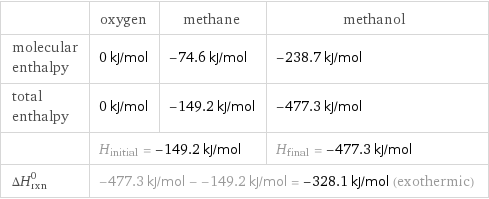
| oxygen | methane | methanol molecular enthalpy | 0 kJ/mol | -74.6 kJ/mol | -238.7 kJ/mol total enthalpy | 0 kJ/mol | -149.2 kJ/mol | -477.3 kJ/mol | H_initial = -149.2 kJ/mol | | H_final = -477.3 kJ/mol ΔH_rxn^0 | -477.3 kJ/mol - -149.2 kJ/mol = -328.1 kJ/mol (exothermic) | |
Gibbs free energy
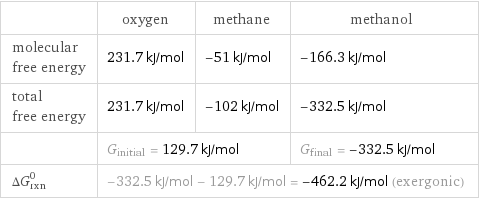
| oxygen | methane | methanol molecular free energy | 231.7 kJ/mol | -51 kJ/mol | -166.3 kJ/mol total free energy | 231.7 kJ/mol | -102 kJ/mol | -332.5 kJ/mol | G_initial = 129.7 kJ/mol | | G_final = -332.5 kJ/mol ΔG_rxn^0 | -332.5 kJ/mol - 129.7 kJ/mol = -462.2 kJ/mol (exergonic) | |
Entropy
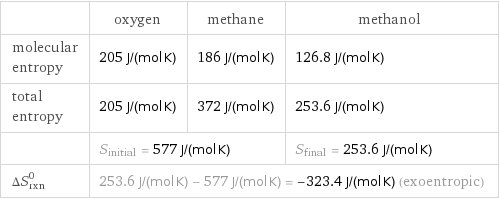
| oxygen | methane | methanol molecular entropy | 205 J/(mol K) | 186 J/(mol K) | 126.8 J/(mol K) total entropy | 205 J/(mol K) | 372 J/(mol K) | 253.6 J/(mol K) | S_initial = 577 J/(mol K) | | S_final = 253.6 J/(mol K) ΔS_rxn^0 | 253.6 J/(mol K) - 577 J/(mol K) = -323.4 J/(mol K) (exoentropic) | |
Equilibrium constant
![Construct the equilibrium constant, K, expression for: O_2 + CH_4 ⟶ CH_3OH Plan: • Balance the chemical equation. • Determine the stoichiometric numbers. • Assemble the activity expression for each chemical species. • Use the activity expressions to build the equilibrium constant expression. Write the balanced chemical equation: O_2 + 2 CH_4 ⟶ 2 CH_3OH Assign stoichiometric numbers, ν_i, using the stoichiometric coefficients, c_i, from the balanced chemical equation in the following manner: ν_i = -c_i for reactants and ν_i = c_i for products: chemical species | c_i | ν_i O_2 | 1 | -1 CH_4 | 2 | -2 CH_3OH | 2 | 2 Assemble the activity expressions accounting for the state of matter and ν_i: chemical species | c_i | ν_i | activity expression O_2 | 1 | -1 | ([O2])^(-1) CH_4 | 2 | -2 | ([CH4])^(-2) CH_3OH | 2 | 2 | ([CH3OH])^2 The equilibrium constant symbol in the concentration basis is: K_c Mulitply the activity expressions to arrive at the K_c expression: Answer: | | K_c = ([O2])^(-1) ([CH4])^(-2) ([CH3OH])^2 = ([CH3OH])^2/([O2] ([CH4])^2)](../image_source/644d358840fb7717857a8676b7fe758d.png)
Construct the equilibrium constant, K, expression for: O_2 + CH_4 ⟶ CH_3OH Plan: • Balance the chemical equation. • Determine the stoichiometric numbers. • Assemble the activity expression for each chemical species. • Use the activity expressions to build the equilibrium constant expression. Write the balanced chemical equation: O_2 + 2 CH_4 ⟶ 2 CH_3OH Assign stoichiometric numbers, ν_i, using the stoichiometric coefficients, c_i, from the balanced chemical equation in the following manner: ν_i = -c_i for reactants and ν_i = c_i for products: chemical species | c_i | ν_i O_2 | 1 | -1 CH_4 | 2 | -2 CH_3OH | 2 | 2 Assemble the activity expressions accounting for the state of matter and ν_i: chemical species | c_i | ν_i | activity expression O_2 | 1 | -1 | ([O2])^(-1) CH_4 | 2 | -2 | ([CH4])^(-2) CH_3OH | 2 | 2 | ([CH3OH])^2 The equilibrium constant symbol in the concentration basis is: K_c Mulitply the activity expressions to arrive at the K_c expression: Answer: | | K_c = ([O2])^(-1) ([CH4])^(-2) ([CH3OH])^2 = ([CH3OH])^2/([O2] ([CH4])^2)
Rate of reaction
![Construct the rate of reaction expression for: O_2 + CH_4 ⟶ CH_3OH Plan: • Balance the chemical equation. • Determine the stoichiometric numbers. • Assemble the rate term for each chemical species. • Write the rate of reaction expression. Write the balanced chemical equation: O_2 + 2 CH_4 ⟶ 2 CH_3OH Assign stoichiometric numbers, ν_i, using the stoichiometric coefficients, c_i, from the balanced chemical equation in the following manner: ν_i = -c_i for reactants and ν_i = c_i for products: chemical species | c_i | ν_i O_2 | 1 | -1 CH_4 | 2 | -2 CH_3OH | 2 | 2 The rate term for each chemical species, B_i, is 1/ν_i(Δ[B_i])/(Δt) where [B_i] is the amount concentration and t is time: chemical species | c_i | ν_i | rate term O_2 | 1 | -1 | -(Δ[O2])/(Δt) CH_4 | 2 | -2 | -1/2 (Δ[CH4])/(Δt) CH_3OH | 2 | 2 | 1/2 (Δ[CH3OH])/(Δt) (for infinitesimal rate of change, replace Δ with d) Set the rate terms equal to each other to arrive at the rate expression: Answer: | | rate = -(Δ[O2])/(Δt) = -1/2 (Δ[CH4])/(Δt) = 1/2 (Δ[CH3OH])/(Δt) (assuming constant volume and no accumulation of intermediates or side products)](../image_source/166e84ba0ff5030eceac7259245e6af9.png)
Construct the rate of reaction expression for: O_2 + CH_4 ⟶ CH_3OH Plan: • Balance the chemical equation. • Determine the stoichiometric numbers. • Assemble the rate term for each chemical species. • Write the rate of reaction expression. Write the balanced chemical equation: O_2 + 2 CH_4 ⟶ 2 CH_3OH Assign stoichiometric numbers, ν_i, using the stoichiometric coefficients, c_i, from the balanced chemical equation in the following manner: ν_i = -c_i for reactants and ν_i = c_i for products: chemical species | c_i | ν_i O_2 | 1 | -1 CH_4 | 2 | -2 CH_3OH | 2 | 2 The rate term for each chemical species, B_i, is 1/ν_i(Δ[B_i])/(Δt) where [B_i] is the amount concentration and t is time: chemical species | c_i | ν_i | rate term O_2 | 1 | -1 | -(Δ[O2])/(Δt) CH_4 | 2 | -2 | -1/2 (Δ[CH4])/(Δt) CH_3OH | 2 | 2 | 1/2 (Δ[CH3OH])/(Δt) (for infinitesimal rate of change, replace Δ with d) Set the rate terms equal to each other to arrive at the rate expression: Answer: | | rate = -(Δ[O2])/(Δt) = -1/2 (Δ[CH4])/(Δt) = 1/2 (Δ[CH3OH])/(Δt) (assuming constant volume and no accumulation of intermediates or side products)
Chemical names and formulas
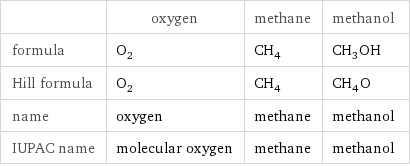
| oxygen | methane | methanol formula | O_2 | CH_4 | CH_3OH Hill formula | O_2 | CH_4 | CH_4O name | oxygen | methane | methanol IUPAC name | molecular oxygen | methane | methanol
Substance properties

| oxygen | methane | methanol molar mass | 31.998 g/mol | 16.04 g/mol | 32.042 g/mol phase | gas (at STP) | gas (at STP) | liquid (at STP) melting point | -218 °C | -182.47 °C | -98 °C boiling point | -183 °C | -161.48 °C | 64.7 °C density | 0.001429 g/cm^3 (at 0 °C) | 6.67151×10^-4 g/cm^3 (at 20 °C) | 0.791 g/cm^3 solubility in water | | soluble | miscible surface tension | 0.01347 N/m | 0.0137 N/m | dynamic viscosity | 2.055×10^-5 Pa s (at 25 °C) | 1.114×10^-5 Pa s (at 25 °C) | 5.44×10^-4 Pa s (at 25 °C) odor | odorless | odorless | pungent
Units
